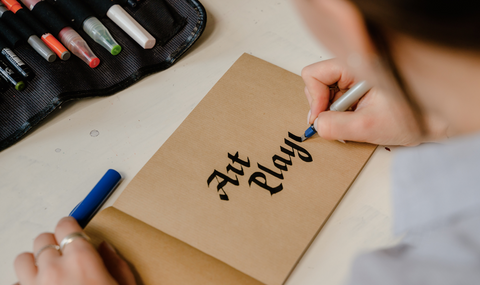Calligraphy is the craft of creating classic letters by hand and positioning them beautifully while hand lettering is the art of illustrating alphabets freestyle. These unique forms of art are becoming increasingly popular and making their name in the world of DIY, creative art and the graphic design universe. The opportunities after learning calligraphy and hand lettering are endless. Best to get started soon - we have 5 simple steps for you to begin your artsy journey.
1. Get Inspired
Inspiration can be sourced from many different places. It could come from the internet, from your daily routine, a magazine or book you read or even from a conversation you had with a friend. Create a mood board on the styles and themes that you would like to explore and keep your mood board as creative and extensive as possible.
2. Start Basic and Repetition Is Key
It is best to start with the basics and learn your strokes. Start out with short sentences or words like “Happy Birthday”, “Thank You” and others. As you are only a beginner in doing calligraphy and hand-lettering, it is okay if the outcome is not as expected. Be patient and take your time with the learning process while figuring out your likes and dislikes when it comes to lettering styles. Remember to be attentive to your movements and the positioning of each letter.

Next, repetition is paramount when it comes to mastering the art of calligraphy and hand-lettering. Download free templates online to start practicing using pencils before moving on to pens and markers. Keep reading to find out Lion File’s recommendation on supplies you will need to get the most out of this craft.
3. Use a Pencil
As mentioned above, pencils will be your new best friend. It makes it easy for you to practice and every mistake can be erased easily, so you can keep going with a peace of mind.Tip: Once you have perfected a sentence with the pencil, use a permanent marker or pen to trace over your writing.
4. The Upstroke
An upstroke as it sounds like, is self-explanatory - it is the movement of your pen going upwards on a piece of paper. This stroke is meant to be light, hence, use as little pressure as possible. Consistency is important when it comes to calligraphy and hand-lettering, hence the applied pressure needs to be controlled for different styles and strokes.
5. The Downstroke
Downstroke, as you can guess - is the movement of your pen going downwards on a piece of paper. Anytime the pen is coming towards you, would be a downstroke and if it is moving away from you, it is an upstroke. As they are opposites, downstroke is meant to be thicker. Hence, you will need to apply additional pressure when you are drawing or writing.
Product Recommendation for Every Lettering Style
Once you have gotten the knack of calligraphy and hand lettering, it is time to switch it up and invest in some essential supplies depending on your needs.
Fancy Letters or Not!
This technique is the ‘copycat’ version of traditional calligraphy. Best to be used with a fine tip. What’s the trick? When the pen is moving downwards, increase the thickness on the downstroke by adding a shadow effect to any part of the alphabet.
The best part about modern calligraphy and hand lettering is its versatility and subjectivity. Have fun and mix it up. Play between different colours and the fusion of uppercase and lowercase. To give it a pang of fun, use different writing styles on the paper!
Get your hands on the Artline 220 Pen 0.2 for a superfine tip for a smooth drawing and writing experience.
Uppercase Block Lettering
Block lettering can be used when you prefer uniformity in your design. All you must do is to ensure that the letters are all in the same size and within the same lines. Draw a faint line using a pencil to ensure your blocks are all in place.
We recommend the Artline 210 Medium Pen 0.6 for a thicker writing style.
Add Colour
Adding colours to your calligraphy and hand lettering could give it a more personalized feel. Instead of the traditional black on an invitation or a “thank-you” card, try adding a splash of colours.
We recommend the Artline 700 Permanent Marker that comes in 7 different colours. If you would like to know more about choosing pen tips, read The Complete Beginner's Guide to Markers.
Watercolour Effect
Watercolour is making a comeback! The combination of calligraphy and hand-lettering technique together with watercolour expertise would result in greatness. Keep in mind that the combination of these techniques could take a lot of practice. - but as we all know, practice makes perfect!
Read Also: 5 Watercolour Pencil Techniques for Beginners
Calligraphy and hand lettering could be just a hobby or you could turn it into a small business by selling beautifully crafted cards, envelopes or poems. In any case, you will need the right tools to join the bandwagon. Head over to Lion File and you can browse the wide range of pens and other supplies to get your interest started.

